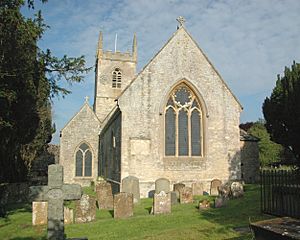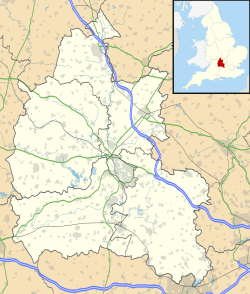St Nicholas' Church, Islip facts for kids
Quick facts for kids St Nicholas' Church, Islip |
|
|---|---|
| Parish church of St Nicholas the Confessor | |

East end of St. Nicholas' parish church
|
|
| 51°49′22.5″N 1°14′16″W / 51.822917°N 1.23778°W | |
| Location | Church Lane, Islip, Oxfordshire OX5 2SD |
| Country | United Kingdom |
| Denomination | Church of England |
| History | |
| Dedication | Saint Nicholas |
| Cult(s) present | Edward the Confessor |
| Architecture | |
| Style | Romanesque, English Gothic, Georgian, Gothic Revival |
| Years built | circa 1200–1861 |
| Administration | |
| Parish | Saint Nicholas the Confessor, Islip, Oxfordshire |
| Deanery | Bicester and Islip |
| Archdeaconry | Oxford |
| Diocese | Oxford |
| Province | Canterbury |
St Nicholas' Church, Islip is a historic Church of England parish church located in the village of Islip, Oxfordshire. Islip is about 3 miles (5 km) east of Kidlington and 5 miles (8 km) north of Oxford. This church has been a central part of the community for many centuries.
Contents
The Church Building: A Look Through Time
People believe that Edward the Confessor, a famous English king, was baptized in a church here around the year 1004. There has been a church on this spot since at least 1065. The church you see today started being built in the late 1100s. It was then largely rebuilt in the 1300s.
The church has several main parts: a chancel (the area around the altar), a nave (the main part where people sit), aisles on both sides, a tall tower at the west end, and a south porch. You can still see some old Romanesque features, like the round arches in the north part of the nave.
Changes Over the Years
In 1780, the chancel was rebuilt. Later, in 1861, an architect named Edward George Bruton made more changes. He redesigned the chancel and "restored" the rest of the church. This means he updated it to fit the popular Gothic Revival style of that time.
Hidden Art: Medieval Wall Paintings
In 1824, some amazing medieval wall paintings were found in the south aisle. These paintings included scenes like the Adoration of the Magi (the wise men visiting baby Jesus) and a "weighing of souls." Experts thought these were painted in the late 1300s.
There was even an older version of the Adoration painting underneath the later one! Another painting showed the Resurrection. Sadly, all these beautiful paintings were covered up with plaster during the 1861 restoration of the church.
Important People Buried Here
A famous person named William Buckland is buried at St Nicholas' Church. He was a theologian (someone who studies religion), a geologist (someone who studies rocks and the Earth), and a palaeontologist (someone who studies fossils).
St Nicholas' Church is a very important building. It is the only Grade I Listed Building in Islip. This means it's considered a building of exceptional historical and architectural interest.
Church Bells and Clock
The church tower once had five bells that were made in the 1600s. In 1859, a company called George Mears recast them into a set of six bells. Later, in 1956, another company increased the number of bells to eight.
The church also has a special bell called a Sanctus bell, which was made in 1652. No one knows exactly when the church clock was made, but it might be from the late 1600s. People think it was made by Edward Hemins.
Past Leaders of the Church
Many important people have served as leaders of the church in Islip. Some of them include John Islip, Robert South, and William Buckland (the geologist). The church is now part of a group of churches called the Benefice of the Ray Valley.
The Old Rectory: A Historic Home
The Rectory is the house where the church leader (the Rector) used to live. Rev. Dr. South, who started Islip's parish school in 1710, had the Rectory built for him in 1689. It's a large house made of Cotswold stone with five sections and attic windows.
The house was made bigger in 1807 and restored in the mid-1800s. The Old Rectory is also a very important building in Islip. It is the only Grade II* Listed Building in the village. This means it's a particularly important building of more than special interest.
King Edward the Confessor's Chapel
Edward the Confessor, who was King of England, was born in Islip around the year 1004. There used to be a special chapel linked to him, located north of the main church. Monks from Westminster Abbey would visit this chapel to celebrate a special day for St. Edward.
During the English Civil War in April 1645, the chapel was damaged in a battle. It was later completely taken down in the 1780s. In 2006, a TV show called Time Team visited Islip. They tried to find the remains of the chapel, but they were not successful.
Images for kids



